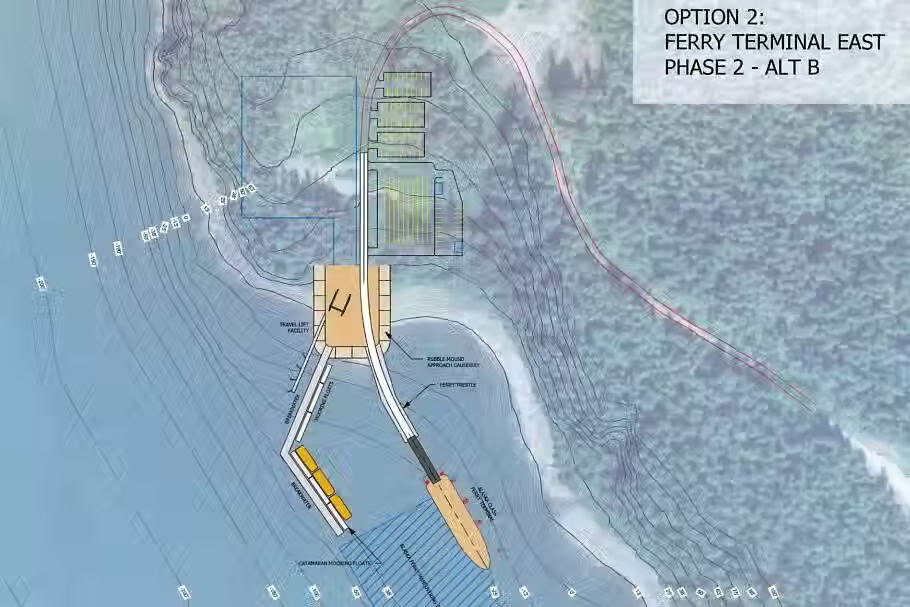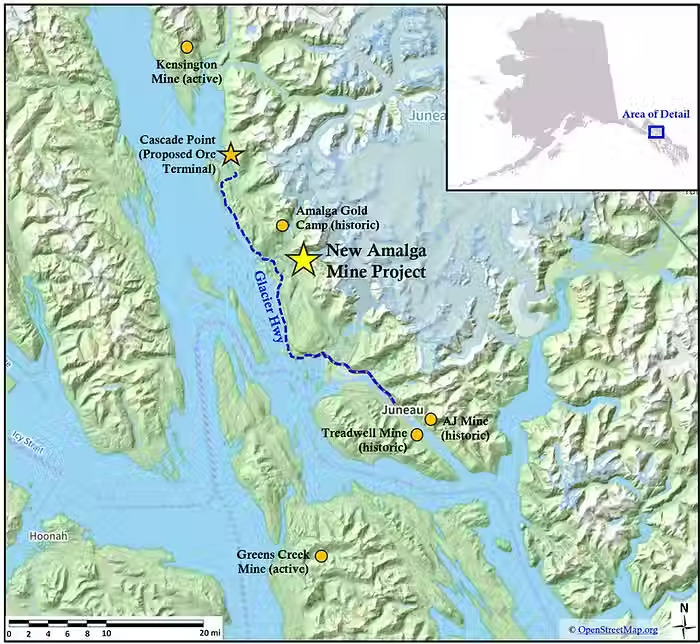Cascade Point terminal has offsetting ferry impacts, big pluses for new mine, state study finds
- Mark Sabbatini

- 4 days ago
- 8 min read
Updated: 4 days ago
Long-awaited DOT economic analysis touts overall benefits of new port 30 miles north of Juneau; some AMHS board members attack findings as a misguided sales pitch

By Mark Sabbatini
Juneau Independent
The Cascade Point ferry terminal offers mixed impacts as an Alaska Marine Highway System hub, but will be a boon to a new mine that ships ore from the site as well as Goldbelt Inc.’s prospects as the property owner, according to a long-awaited economic analysis by the state.
The analysis was strongly criticized by a majority of the eight-member Alaska Marine Highway Operations Board (AMHOB) during a meeting Friday, with one comparing it to a timeshare brochure.
"I think that the document itself has kind of been put together in a very workman-like way to try and — what I would say — build the case for Cascade Point, as opposed to evaluate options," Wanetta Ayers, the board’s chair, said while members were discussing their initial impressions of the report. The timeshare comparison was made by a different member.
Board members agreed a special meeting, possibly in early December, is needed to evaluate if the project and analysis are at odds with the board’s oversight responsibilities.
Meanwhile, Grande Portage Resources Ltd., which plans to build an ore shipping facility at Cascade Point for its Amalga Gold Project, is lauding the state’s cooperation in advancing a project the company’s CEO says offers "excellent gold payabilities."
"The project hosts a high-grade mineral resource of 1.4 million ounces of gold (indicated) and 0.5 million ounces (inferred) and remains open to expansion in multiple directions," the company announced in an Oct. 20 press release. "The current development concept envisions a small-footprint underground mining operation with third-party offsite processing, eliminating the need for an onsite mill or tailings storage facility."
A $28.5 million state agreement was signed by the state in July for the first phase of work on the land at Cascade Point owned by Goldbelt that is about 30 miles north of Juneau. The company has a range of tourism, resource development and other ventures in the region.
"The development of New Amalga Mine has the potential for substantial economic development in the region," the state’s study notes. It also states "Goldbelt views the project as an opportunity to demonstrate Alaska Native leadership in infrastructure development and to create shareholder employment and revenue."
The many controversies about the economic, environmental, transportation and other impacts of the ferry terminal are noted in the analysis by the Alaska Department of Transportation and Public Facilities. But the bottom line is a strong endorsement that brushes aside the concerns.
"The Cascade Point project generally moves social and cultural issues in a positive direction while providing environmental benefits that outweigh localized ecological risks," a summary at the end of the report notes. "Most concerns raised — such as habitat impacts, cultural resource disturbance, and access equity — are fully addressable through mitigation, regulatory oversight, and planned infrastructure support."
That assessment comes despite a finding that the terminal has offsetting advantages and disadvantages when considered solely in terms of its impact on state ferry operations.
"The extensive capital costs of the Cascade Point terminal are difficult to justify based solely on operational cost savings," the analysis states. "In isolation, the project provides modest reliability gains and reduces emissions but also introduces new infrastructure responsibilities and long-term maintenance obligations."
"However, the project’s perceived value increases when broader considerations are taken into account," the study adds. It further asserts "the decision ultimately depends on how much weight policymakers assign to social value, long-term resilience, environmental considerations, and system-wide efficiency."
18% reduction in travel time, 7% increase in costs
A trip from the Mendenhall Mall to Haines via the current Auke Bay Ferry Terminal takes about 345 minutes, including eight minutes of driving and 272 minutes aboard the ship, according to the analysis. It states the trip would take about 282 minutes via Cascade Point, including 41 minutes of driving and 176 minutes on the ship.
"This 18% reduction in total travel time is expected to result in a 4% to 8% increase in ridership," the study asserts.
But that gain would be partially offset by a 7% increase in travel costs — mostly driving related — that would reduce overall ridership 1% to 2%, according to the analysis. The study assumes ferry ticket prices will remain the same — $120 for vehicles and $135 for three passengers — regardless of which terminal the ferry departs from.
The impact would be greater on people without vehicles who would have to rely on taxis or other means of transport to get between Cascade Point and Juneau, the study notes. It also notes Goldbelt plans to provide shuttle service between the Mendenhall Valley and Cascade Point, and therefore "no additional change in demand is assumed for walk-on passengers" — although that could change if the cost of the shuttle is deemed too high by consumers.
Departing from Cascade Point will save the ferry system fuel, maintenance and other costs, but not enough to "fully recover construction costs," according to the study notes.
The assumptions about cost and ridership were among the questions about the analysis raised Friday by AMHOB member Bob Horchover.
"It read to me like a timeshare brochure," he said. "I don't think it was realistic and I'm not sure where they got some of their numbers. I don't know what kind of cars are going to be driving out there that are going to get 28 miles a gallon. I was quite surprised that it seemed like it was not really anchored in reality."
Another board complaint is that, while the analysis provides estimates for initial expenses at the Cascade Point ferry terminal, the data is incomplete.
"I was just very disappointed as I didn't see a fact on what's the final cost of this terminal going to be to this state on an annual basis?" Larry Carson, an AMHOB member living in Pelican. "It's like me asking my wife for $5,000 to go buy a new truck, and she gives it to me and and I never tell her how much it's going to cost at the very end. We have to have a plan on what it's going to cost and is it worth it to the state?"
The analysis acknowledges that, purely in financial terms, the Cascade Point terminal essentially has offsetting gains and losses — and plenty of unknowns. But the study also argues there are positive factors beyond that bottom line.
"The project offers quantifiable operational efficiencies and emissions reductions, along with the potential to support tribally affiliated infrastructure and industrial logistics development," the study notes. "These benefits are offset by longer drive times for Juneau-based passengers, increased infrastructure responsibilities, and uncertainty regarding long-term financial returns."
"From a fiscal perspective, direct Alaska Marine Highway System (AMHS) savings do not yield attractive financial returns on investment. However, the project yields public-sector outcomes typical of state-funded infrastructure, including improved reliability, lower emissions, and increased system flexibility. These align with AMHS’s mandate to provide essential public transportation, independent of profitability."
Wider economic benefits touted
A near-certain winner of the Cascade Point terminal is Grande Portage’s mining venture, according to the analysis.
"The most promising opportunity for sustained economic growth lies in the proposed New Amalga mine, which is expected to use Cascade Point for logistics," the report states. "If the mine develops along a trajectory similar to the nearby Kensington Mine, it could generate 250–400 ongoing regional jobs during operations and several hundred more during its development phase. This outcome, however, is contingent on further exploration results and regulatory approvals and is therefore speculative at this stage."

Goldbelt, as an Alaska Native urban corporation that owns the land at Cascade Point, "also supports the project as an opportunity to demonstrate Native leadership in regional infrastructure development," the report states.
"Goldbelt anticipates benefits including land-based revenue, new contracting opportunities, and shareholder employment, with an emphasis on local hiring and workforce development," the analysis asserts. "From Goldbelt’s perspective, Cascade Point could serve as a model for how Native-owned lands can be leveraged for public infrastructure while advancing tribal economic participation and stewardship. Broader impacts on tribal empowerment will depend on long-term project outcomes and engagement with other Native and cultural organizations."
The City and Borough of Juneau could also benefit since development at Cascade Point and surrounding properties might expand the municipality’s property tax base, although that prospect is "too speculative to quantify," according to the analysis. Such development could also generate additional economic activity — both during construction and afterward among homes/businesses there.
Between 75 and 152 full-time equivalent (FTE) jobs for a period of five years are expected to be created by the ferry terminal’s construction, according to the study.
"These include direct construction workers, support services (e.g., fuel suppliers, equipment rental, hospitality), and induced jobs from household spending," the study notes. "Most of these jobs will be completed when construction is completed."
Other regional industries may be affected by the new terminal, but the total level of activity is expected to be about the same, according to the analysis.
"Outside of mining, most other effects — including tourism, commuting, and general freight handling — are best described as redistributive rather than generative," the report states.
Board members criticizing the analysis at their meeting Friday said one of their biggest concerns is the Cascade Point terminal is largely at odds with the intent of the Alaska Marine Highway System’s Long Range Plan unveiled last year. The plan details a range of proposed vessel, port and operational upgrades during the next 20 years.
"When we started this everything was based on needs," AMHOB board member Paul Johnsen said. "What do the communities need? What do we need to have reliable ferries? What do we need for the terminals to interchange different ships? And I don't see that we have a need for an additional ferry terminal. So I don't like this — the new changes made to the long-range plan — and I'm guessing they're politically motivated, and I think we should vote on whether we support the changes or not."
Ferry board seeking more details before taking action
AMHOB discussed and ultimately tabled a motion to send a letter to the Alaska Legislature declaring the analysis a deviation from the ferry system’s long-range plan that would include a "corrective action report." Most members agreed, however, quick action should be taken to gather more data and input from affected communities about the Cascade Point project — and the ferry’s board oversight responsibilities.
Ayers said the board’s role has been elevated from an advisory board in earlier years to an operations board so members can take steps such as providing corrective action declarations to the Legislature.
"The real desire is for the system to work and be unencumbered by misdirection," she said.
Board members noted that significant opposition to the Cascade Point terminal has been expressed by nearby communities, including formal resolutions from the Skagway and Haines borough assemblies.
"My impression of the public, at least in Juneau, is that this is a bit of a very narrow, focused project for a very narrow group of people that seem to think that this is some kind of an answer, or they're paying off some favor somewhere," Horchover said. "I don't know exactly what the motivation is, but it sure isn't for the good of the Alaska Marine Highway service."
Board member Anthony Lindoff said that while "I do speak from a pro-economic development strategy," he questions how realistic the state’s analysis is and "I would like more time to look at this."
The board agreed a special board meeting focusing on Cascade Point and involving various stakeholders should occur before the next regularly scheduled meeting in January. Ayers said early December is the soonest likely date such a meeting can realistically take place.
"The difficult part is that capital is already being allocated to this project, absent all of those things," she said. "So it feels like a process that really needs more rigor, especially based on the level of cost that is associated with this project."
• Contact Mark Sabbatini at editor@juneauindependent.com or (907) 957-2306.














